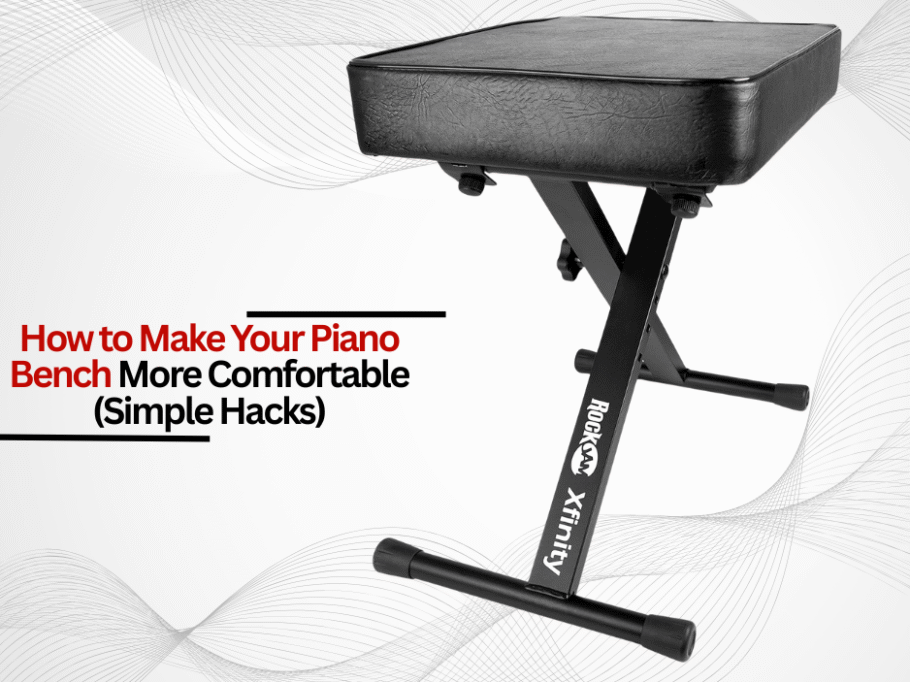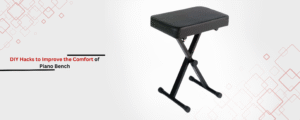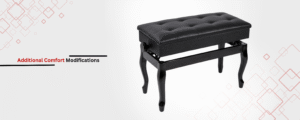Piano benches aren’t usually regarded as deserving of comfort, but they are an important factor that affects playing posture, comfort, endurance, and overall enjoyment. Over time, rigid seating can lead to discomfort, fatigue, or musculoskeletal strain. The good thing is that they can be worked on without having to hire professionals, and in a few simple adjustments you can achieve a lot and improve piano bench comfort. Misalignment of certain body parts can cause pain or other issues, which is why the below tips are provided to alleviate the pain and discomfort.
To know more, read: Why a Good Piano Bench Matters More Than You Think
Why Piano Bench Comfort Matters
The Link Between Comfort and Performance:
It goes without saying that extended periods of practice require proper posture and support. An adjustable bench can greatly improve the experience by allowing proper setting of the height and slumping posture and regulating ease of motion. Poorly designed seat refers to benches that equally poorly slouch or lean. Pedal-assisted seating promotes comfort alongside providing proper posture and restraining movements, making musicians physically relaxed and at ease.
Common Issues with Standard Benches:
- Deficient Padding: Cushion reflects uneven distribution of weight and is rather thin.
- Inadequate Posture Support: Fixed-height benches of a specific height pay no need to anatomical variations alongside mutual differences.
- Lack of Adjustability: dynamic designs that accommodate the wide variety of ways of playing the piano
Evaluating the existing Piano Bench
Step 1: Alignment Check
Positioned sitting comfortably, a pianist is expected to have their elbows bent at an angle of around 90 to 100 degrees, arching rest on the keys. Feet should be positioned flat and thighs parallel or slightly angled positioned downward.
Step 2: Pressure Point Test
If after half an hour of usage, there is soreness in the tailbone, thighs, or lower back, it is a sign that the lack of cushioning is uncomfortable.
Step 3: Adjustability Evaluation
If the bench height is fixed and cannot be altered, it may lead to hunching and slouching as posture alignment could be out of place.
DIY Hacks to Improve Comfort on the Piano Bench
Hack 1: Make Custom Cushions to Add Padding to the Bench
This do-it-yourself hack involves making a cushion that will greatly improve comfort while sitting on the bench.
Materials Needed:
- Cotton fabric, faux leather, or velvet upholstery fabric.
- High-density foam, 1.5-2 inches thick.
- Betting (optional), scissors, and a staple gun.
Instructions:
- Cut the foam into pieces that will fit the seats of the bench.
- (Optional): Batting is wrapped around the foam to soften edges
- Fabric is pulled over the foam and secured to the bench using a staple gun. The fabric is pulled tight and secured on the underside of the bench.
- Excess fabric is trimmed, and corners are folded neatly.
Important tip: It’s best to use memory foam or gel-infused padding if the cushion will be used for extended periods during gameplay.
Hack 2: Reupholster the Existing Seat
Reupholstering is a great way to revamp padding and change the look for benches with removable lids.
Steps:
- With a flathead screwdriver, pull staples to remove existing upholstery.
- A worn-out piece of plywood is now replaced with new foam padding or other cushioning material.
- Staple the new fabric onto the lid, smoothing it out to ensure no creases form.
Hack 3: Attach a Lumbar Support Pillow
Strapping external lumbar support helps eliminate lower back pain.
Options:
- An orthopedic pillow can be fitted and unstrapped from the bench’s backrest.
- Foam wedges are placed at the seat’s back to smoothly rotate the sitting pelvis towards the spinal column’s anterior, thus facilitating good posture.
Additional Comfort Modifications
Adjustable Height Solutions:
Where the benches do not have adjustable height features, raisers or blocks are used to elevate the bench. On the other hand, padded footrests can be used to lower the height of the bench.
Stability and Anti-Slip Additions:
Incredibly active and competitive individuals often move the bench, and so it is fitted with rubberized grips or adhesive non-slip mats added to the base to stop any sliding during competitive play.
Cleaning & Maintenance for Enhanced Comfort
- Dust Removal: Ensuring the optimal solution is free of any and all soft debris is critical to maintaining the integrity of the cushion; therefore, regular upholstery vacuuming maintains the fabric.
- Foam Rotation: To ensure no build-up of excessive strain, periodic means can result from rotating the cushion.
- Lubrication: Oiling all hinges of adjustable benches is greater than twice a year, guaranteeing the changing of height is easy.
When is it Time to Change
If nothing seems to work after all DIY adaptations, purchasing a custom bench will most likely be the solution. Adjusting the tilt, adding split seating, memory foam, and a touch of modern ergonomics will have you covered.
Conclusion
With a few do-it-yourself tips, a piano bench can easily be converted into an ergonomic and comfy seat on a budget. The addition of padding, reupholstering the seat, or adding lumbar support modifies the bench while placing primary emphasis on health and efficiency. For ready-made options, you can buy from renowned brands such as On Stage, 5 Core, Roland, and Donner, which offer benches with advanced ergonomic comfort features. These commercial products draw attention to the benefits of ergonomic comfort features, allowing musicians to concentrate on the performance instead of discomfort. A combination of DIY creativity and quality products transforms the piano bench from a simple tool into a versatile instrument of musical creativity.




